warning DODGE DURANGO SRT 2019 Vehicle Warranty
[x] Cancel search | Manufacturer: DODGE, Model Year: 2019, Model line: DURANGO SRT, Model: DODGE DURANGO SRT 2019Pages: 270, PDF Size: 2.52 MB
Page 168 of 270
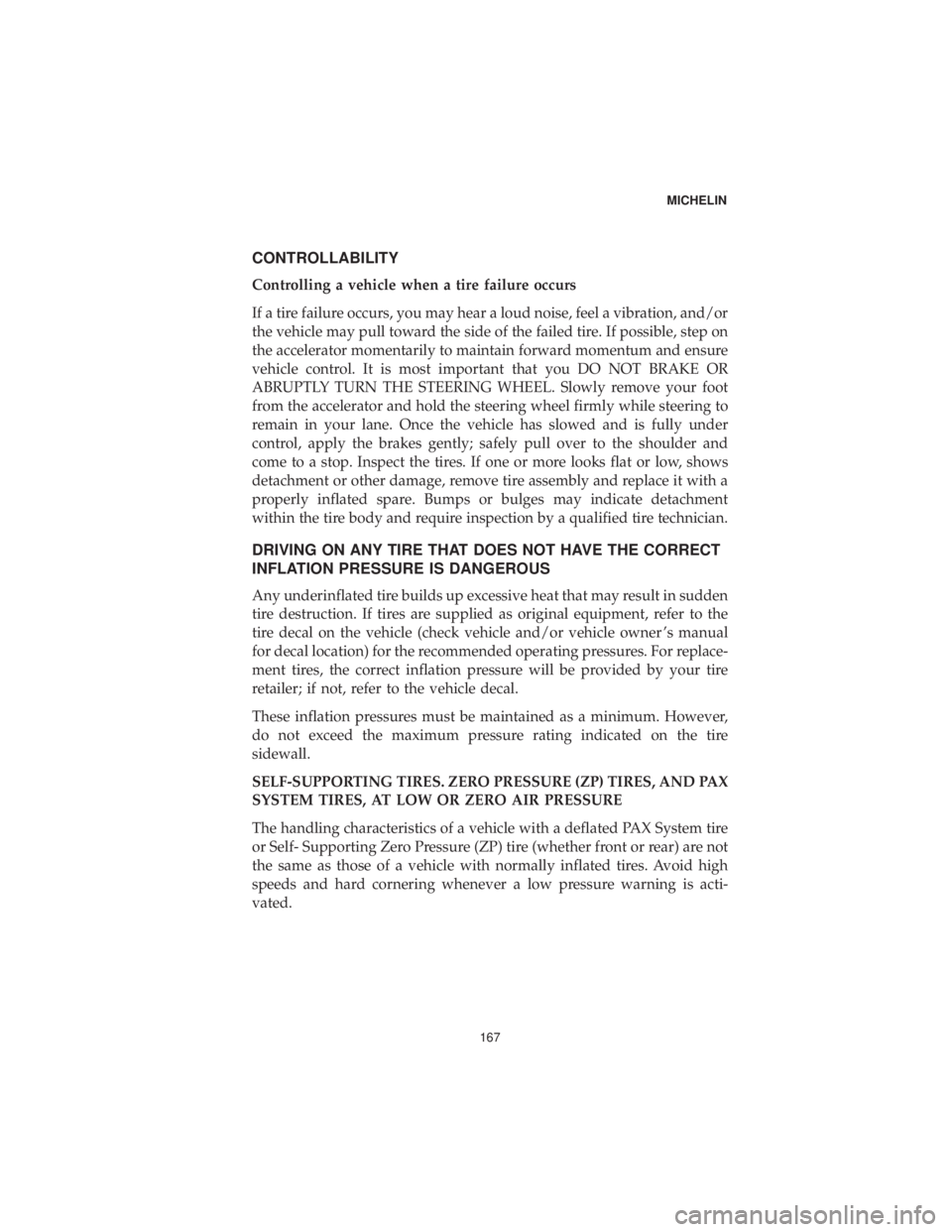
CONTROLLABILITY
Controlling a vehicle when a tire failure occurs
If a tire failure occurs, you may hear a loud noise, feel a vibration, and/or
the vehicle may pull toward the side of the failed tire. If possible, step on
the accelerator momentarily to maintain forward momentum and ensure
vehicle control. It is most important that you DO NOT BRAKE OR
ABRUPTLY TURN THE STEERING WHEEL. Slowly remove your foot
from the accelerator and hold the steering wheel firmly while steering to
remain in your lane. Once the vehicle has slowed and is fully under
control, apply the brakes gently; safely pull over to the shoulder and
come to a stop. Inspect the tires. If one or more looks flat or low, shows
detachment or other damage, remove tire assembly and replace it with a
properly inflated spare. Bumps or bulges may indicate detachment
within the tire body and require inspection by a qualified tire technician.
DRIVING ON ANY TIRE THAT DOES NOT HAVE THE CORRECT
INFLATION PRESSURE IS DANGEROUS
Any underinflated tire builds up excessive heat that may result in sudden
tire destruction. If tires are supplied as original equipment, refer to the
tire decal on the vehicle (check vehicle and/or vehicle owner ’s manual
for decal location) for the recommended operating pressures. For replace-
ment tires, the correct inflation pressure will be provided by your tire
retailer; if not, refer to the vehicle decal.
These inflation pressures must be maintained as a minimum. However,
do not exceed the maximum pressure rating indicated on the tire
sidewall.
SELF-SUPPORTING TIRES. ZERO PRESSURE (ZP) TIRES, AND PAX
SYSTEM TIRES, AT LOW OR ZERO AIR PRESSURE
The handling characteristics of a vehicle with a deflated PAX System tire
or Self- Supporting Zero Pressure (ZP) tire (whether front or rear) are not
the same as those of a vehicle with normally inflated tires. Avoid high
speeds and hard cornering whenever a low pressure warning is acti-
vated.
MICHELIN
167
Page 169 of 270
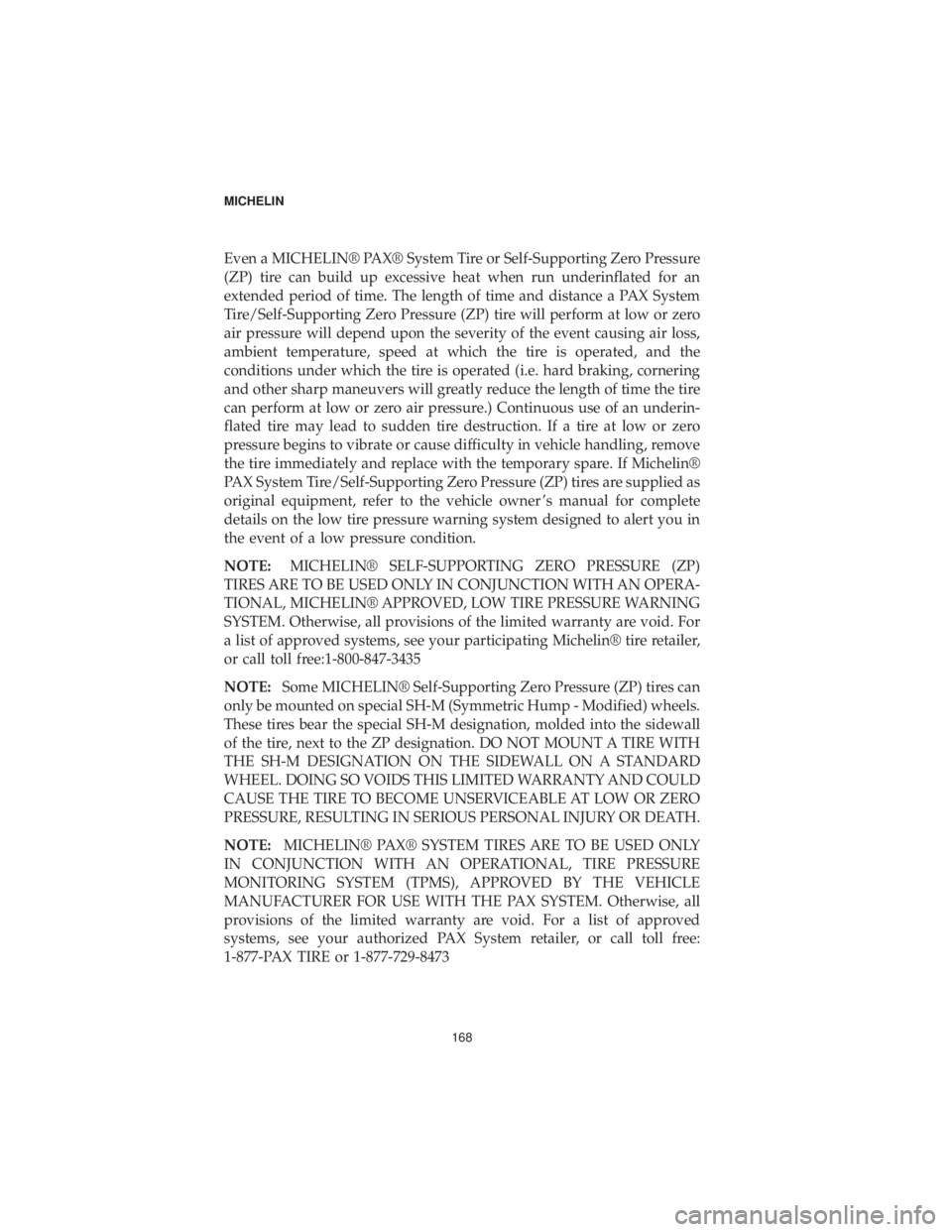
Even a MICHELIN® PAX® System Tire or Self-Supporting Zero Pressure
(ZP) tire can build up excessive heat when run underinflated for an
extended period of time. The length of time and distance a PAX System
Tire/Self-Supporting Zero Pressure (ZP) tire will perform at low or zero
air pressure will depend upon the severity of the event causing air loss,
ambient temperature, speed at which the tire is operated, and the
conditions under which the tire is operated (i.e. hard braking, cornering
and other sharp maneuvers will greatly reduce the length of time the tire
can perform at low or zero air pressure.) Continuous use of an underin-
flated tire may lead to sudden tire destruction. If a tire at low or zero
pressure begins to vibrate or cause difficulty in vehicle handling, remove
the tire immediately and replace with the temporary spare. If Michelin®
PAX System Tire/Self-Supporting Zero Pressure (ZP) tires are supplied as
original equipment, refer to the vehicle owner ’s manual for complete
details on the low tire pressure warning system designed to alert you in
the event of a low pressure condition.
NOTE:MICHELIN® SELF-SUPPORTING ZERO PRESSURE (ZP)
TIRES ARE TO BE USED ONLY IN CONJUNCTION WITH AN OPERA-
TIONAL, MICHELIN® APPROVED, LOW TIRE PRESSURE WARNING
SYSTEM. Otherwise, all provisions of the limited warranty are void. For
a list of approved systems, see your participating Michelin® tire retailer,
or call toll free:1-800-847-3435
NOTE: Some MICHELIN® Self-Supporting Zero Pressure (ZP) tires can
only be mounted on special SH-M (Symmetric Hump - Modified) wheels.
These tires bear the special SH-M designation, molded into the sidewall
of the tire, next to the ZP designation. DO NOT MOUNT A TIRE WITH
THE SH-M DESIGNATION ON THE SIDEWALL ON A STANDARD
WHEEL. DOING SO VOIDS THIS LIMITED WARRANTY AND COULD
CAUSE THE TIRE TO BECOME UNSERVICEABLE AT LOW OR ZERO
PRESSURE, RESULTING IN SERIOUS PERSONAL INJURY OR DEATH.
NOTE: MICHELIN® PAX® SYSTEM TIRES ARE TO BE USED ONLY
IN CONJUNCTION WITH AN OPERATIONAL, TIRE PRESSURE
MONITORING SYSTEM (TPMS), APPROVED BY THE VEHICLE
MANUFACTURER FOR USE WITH THE PAX SYSTEM. Otherwise, all
provisions of the limited warranty are void. For a list of approved
systems, see your authorized PAX System retailer, or call toll free:
1-877-PAX TIRE or 1-877-729-8473
MICHELIN
168
Page 170 of 270

For all types of tires, consult your vehicle tire placard or owner ’s manual
for recommended operating pressures. If the tires are purchased as
replacement tires, operating instructions for the low pressure warning
system will be provided by the manufacturer of that system. Recom-
mended operating pressures will be provided by a participating Michelin
tire retailer for self supporting ZP tires. Recommended operating pres-
sure for PAX System Tires will be provided by a PAX System retailer.
These inflation pressures must be maintained as a minimum. However,
do not exceed the maximum pressure rating indicated on the tire
sidewall.
CHECK THE COLD INFLATION PRESSURES IN ALL YOUR TIRES,
INCLUDING THE SPARE, AT LEAST ONCE EACH MONTH
Failure to maintain correct inflation may result in improper vehicle
handling and may cause rapid and irregular tire wear, sudden tire
destruction, loss of vehicle control and serious personal injury. Therefore,
inflation pressures should be checked at least once each month and
always prior to long distance trips. This applies to all tires, including
sealant types, and Self-Supporting Zero Pressure (ZP) tires which are as
susceptible to losing air pressure as any other type of tire if not properly
maintained.
UNDERINFLATION
It is impossible to determine whether tires are properly inflated by
simply looking at them. It is almost impossible to “feel or hear” when a
tire is being run underinflated or nearly flat. Tires must be checked
monthly with a tire pressure gauge.
Pressures should be checked when tires are cold, in other words, before
they have been driven on. Driving, even for a short distance, causes tires
to heat up and air pressure to increase.
Checking pressure when tires are hot:
If pressures are checked after tires have been driven for more than three
minutes or more than one mile, (2 km) the tires become hot and the
pressures will increase by approximately 4 psi. Therefore when the tire
pressure is adjusted under these conditions, it should be increased to a
gauge reading of 4 psi greater than the recommended cold inflation
pressure.
MICHELIN
169
Page 171 of 270
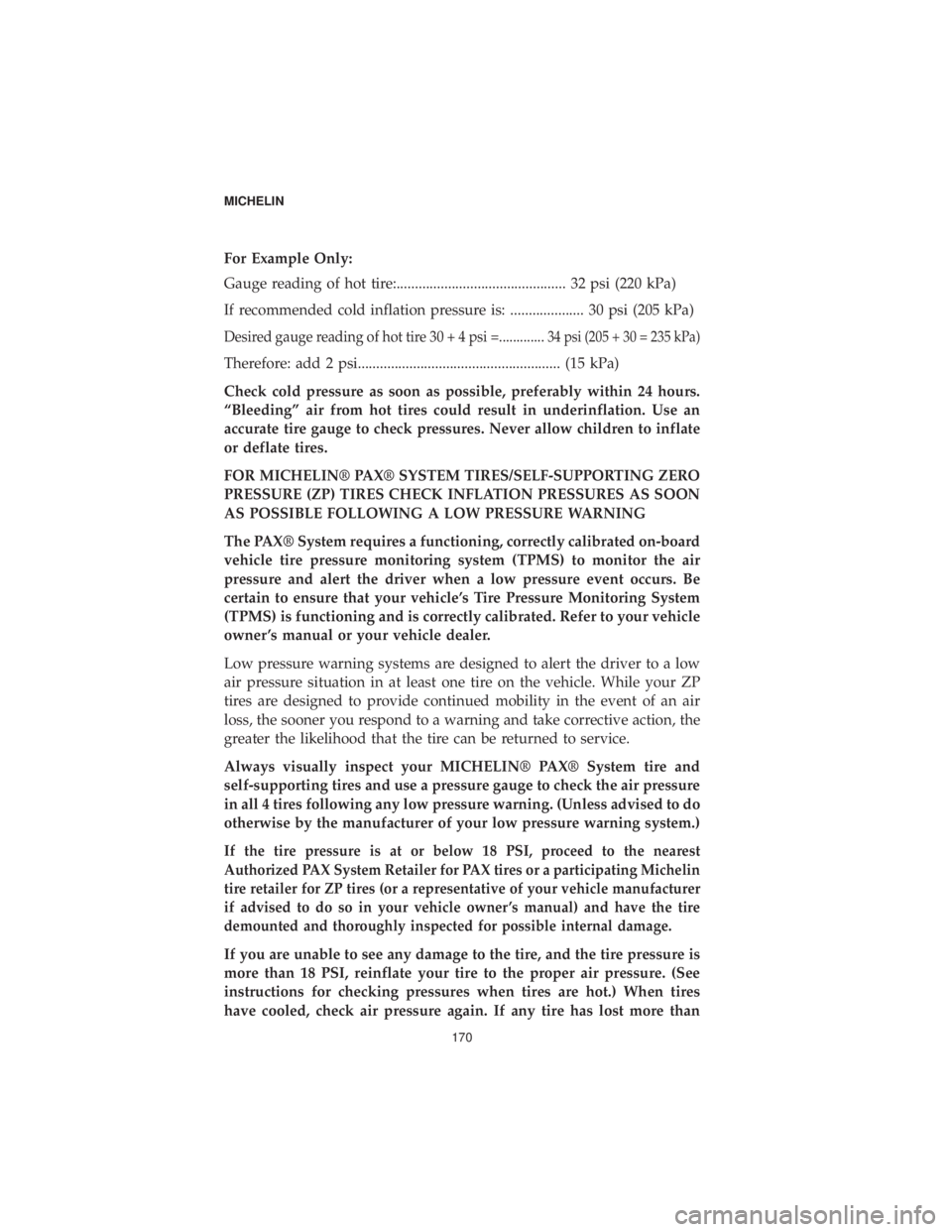
For Example Only:
Gauge reading of hot tire:.............................................. 32 psi (220 kPa)
If recommended cold inflation pressure is: .................... 30 psi (205 kPa)
Desired gauge reading of hot tire 30 + 4 psi =.............34 psi (205 + 30 = 235 kPa)
Therefore: add 2 psi....................................................... (15 kPa)
Check cold pressure as soon as possible, preferably within 24 hours.
“Bleeding” air from hot tires could result in underinflation. Use an
accurate tire gauge to check pressures. Never allow children to inflate
or deflate tires.
FOR MICHELIN® PAX® SYSTEM TIRES/SELF-SUPPORTING ZERO
PRESSURE (ZP) TIRES CHECK INFLATION PRESSURES AS SOON
AS POSSIBLE FOLLOWING A LOW PRESSURE WARNING
The PAX® System requires a functioning, correctly calibrated on-board
vehicle tire pressure monitoring system (TPMS) to monitor the air
pressure and alert the driver when a low pressure event occurs. Be
certain to ensure that your vehicle’s Tire Pressure Monitoring System
(TPMS) is functioning and is correctly calibrated. Refer to your vehicle
owner ’s manual or your vehicle dealer.
Low pressure warning systems are designed to alert the driver to a low
air pressure situation in at least one tire on the vehicle. While your ZP
tires are designed to provide continued mobility in the event of an air
loss, the sooner you respond to a warning and take corrective action, the
greater the likelihood that the tire can be returned to service.
Always visually inspect your MICHELIN® PAX® System tire and
self-supporting tires and use a pressure gauge to check the air pressure
in all 4 tires following any low pressure warning. (Unless advised to do
otherwise by the manufacturer of your low pressure warning system.)
If the tire pressure is at or below 18 PSI, proceed to the nearest
Authorized PAX System Retailer for PAX tires or a participating Michelin
tire retailer for ZP tires (or a representative of your vehicle manufacturer
if advised to do so in your vehicle owner ’s manual) and have the tire
demounted and thoroughly inspected for possible internal damage.
If you are unable to see any damage to the tire, and the tire pressure is
more than 18 PSI, reinflate your tire to the proper air pressure. (See
instructions for checking pressures when tires are hot.) When tires
have cooled, check air pressure again. If any tire has lost more than
MICHELIN170
Page 177 of 270
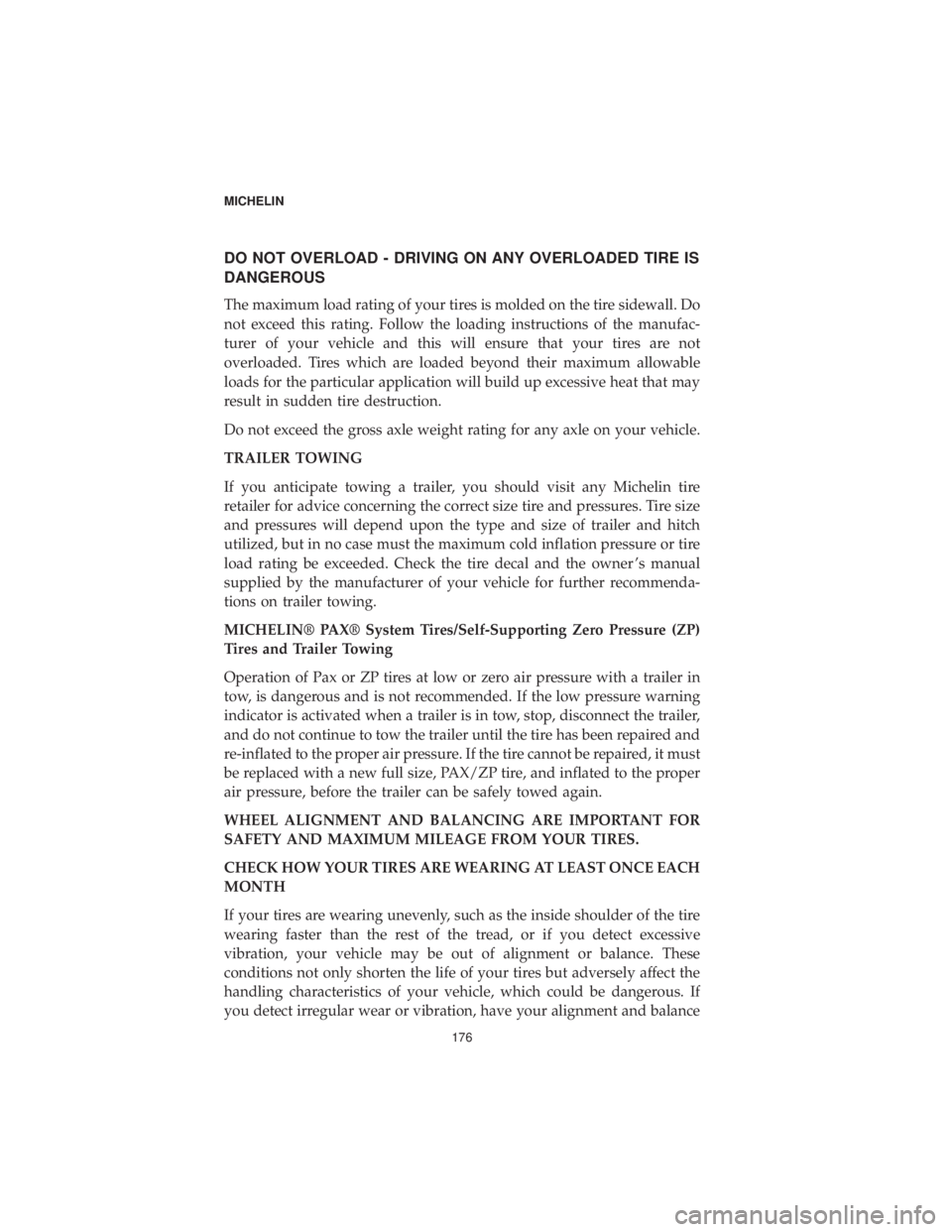
DO NOT OVERLOAD - DRIVING ON ANY OVERLOADED TIRE IS
DANGEROUS
The maximum load rating of your tires is molded on the tire sidewall. Do
not exceed this rating. Follow the loading instructions of the manufac-
turer of your vehicle and this will ensure that your tires are not
overloaded. Tires which are loaded beyond their maximum allowable
loads for the particular application will build up excessive heat that may
result in sudden tire destruction.
Do not exceed the gross axle weight rating for any axle on your vehicle.
TRAILER TOWING
If you anticipate towing a trailer, you should visit any Michelin tire
retailer for advice concerning the correct size tire and pressures. Tire size
and pressures will depend upon the type and size of trailer and hitch
utilized, but in no case must the maximum cold inflation pressure or tire
load rating be exceeded. Check the tire decal and the owner ’s manual
supplied by the manufacturer of your vehicle for further recommenda-
tions on trailer towing.
MICHELIN® PAX® System Tires/Self-Supporting Zero Pressure (ZP)
Tires and Trailer Towing
Operation of Pax or ZP tires at low or zero air pressure with a trailer in
tow, is dangerous and is not recommended. If the low pressure warning
indicator is activated when a trailer is in tow, stop, disconnect the trailer,
and do not continue to tow the trailer until the tire has been repaired and
re-inflated to the proper air pressure. If the tire cannot be repaired, it must
be replaced with a new full size, PAX/ZP tire, and inflated to the proper
air pressure, before the trailer can be safely towed again.
WHEEL ALIGNMENT AND BALANCING ARE IMPORTANT FOR
SAFETY AND MAXIMUM MILEAGE FROM YOUR TIRES.
CHECK HOW YOUR TIRES ARE WEARING AT LEAST ONCE EACH
MONTH
If your tires are wearing unevenly, such as the inside shoulder of the tire
wearing faster than the rest of the tread, or if you detect excessive
vibration, your vehicle may be out of alignment or balance. These
conditions not only shorten the life of your tires but adversely affect the
handling characteristics of your vehicle, which could be dangerous. If
you detect irregular wear or vibration, have your alignment and balance
MICHELIN176
Page 210 of 270

to the tire’s sidewall. Under inflation causes excessive flexing, deteriora-
tion of the tire and rapid wear of the tread edges. Over inflation results
in an uncomfortable ride, a reduced area of tire contact with the road
surface (i.e., smaller tire footprint), higher susceptibility to impact
damage and rapid wear on the tread center.
WARNING!
Driving on tires with improper inflation pressure is dangerous.
These situations can cause a tire failure, including tread/belt
separation, even at a later date, which could lead to an accident and
serious personal injury or death.
Inflation pressure must be checked at least once a month and should be
checked only when the tire is cold or before it has been driven. Driving
even a short distance (1 kilometer or 2 to 3 minutes) causes tires to heat
up and the air pressure to increase approximately 4 psi. In case it is
necessary to adjust the air pressure in tires that have been driven, the air
pressure should be increased to a gauge reading of 4 psi higher than the
recommended cold inflation pressure.
For Example Only:
Gauge Reading of Hot Tire: 27 PSI.
Recommended Cold Inflation Pressure: 26 PSI
Desired Gauge Reading of Hot Tire: 26 PS I+4PSI=30PSI
Therefore: Add 3 PSI
Check the cold inflation pressure on the tires, at least by the next day.
Never reduce or “bleed” pressure from hot tires since your tires will then
be underinflated when they cool down. Always use a reliable pressure
gauge.
4. UHP Summer Tires
Rubber compounds formulated for ultra high performance summer tires
can lose flexibility and may develop random surface cracks at cold
temperatures. Therefore extra care should be used in handling tires in this
condition. These compounds are optimized for maximum dry and wet
performance in warm conditions. Special tread compounds in these tires
will have decreased performance, such as lateral and braking traction, at
temperatures below 7° C or when driving on snow or ice. Therefore, it is
recommended to install winter tires in these conditions.
PIRELLI TIRES
209
Page 213 of 270

TO MAINTAIN PROPER VEHICLE DYNAMICS AND LOAD CARRY-
ING CAPACITY, REPLACEMENT TIRES MUST ALWAYS HAVE A
LOAD INDEX AND SPEED SYMBOL EQUAL TO OR GREATER THAN
THOSE FITTED AS ORIGINAL EQUIPMENT.
When making plus size fitments, you should consult with the dealer
regarding any suspension or braking system modifications which may be
recommended for the vehicle.
9. Tire Inspection
As a minimum, tires (including the spare tire) should be examined and air
pressure checked monthly and always prior to long trips. They should also
be examined if you strike any unusual object on the road. Tires showing
bulges, cracks, cuts, penetrations or uneven wear must be dismounted and
examined by an authorized Pirelli tire dealer and replaced if necessary.
Pirelli tires have treadwear indicators in the tread grooves, which show up
when the tread has worn to 2/32” remaining. At this point, your tires must
be replaced because they are illegal and dangerous.
The mere passage of time (age) does not cause tires to deteriorate, but
rather exposure to outside forces. Such outside forces can include, but are
not limited to: road hazards, punctures, improper repairs, misalignment,
under inflated operation, over inflated operation, excessive heat caused
by over deflected operation, excessive exposure to ozone, improper
storage conditions, etc. Tire companies can only have an impact on a few
of these exposures. Tire companies add antiozinants and anti-oxidants
(anti-degradation compounds) to minimize degradation. Pirelli believes
that since there is no way to accurately predict what outside forces a tire
will be exposed to there is no scientifically supportable age limit that can
be set for tires.
To avoid cosmetic damage, use a mild soap solution to clean sidewalls
and rinse off with low-pressure tap water. Never apply cleaners or
dressings to enhance sidewall appearance to avoid removal of antioxi-
dants, which are intended to prevent ozone degradation. The removal of
anti-oxidants may degrade the rubber and can lead to sidewall cracking.
Use of high-pressure sprayers may cause sidewall damage.
WARNING!
Driving on a damaged tire is dangerous, as the tire can suddenly fail,
which can lead to an accident and serious personal injury or death.
PIRELLI TIRES212
Page 214 of 270
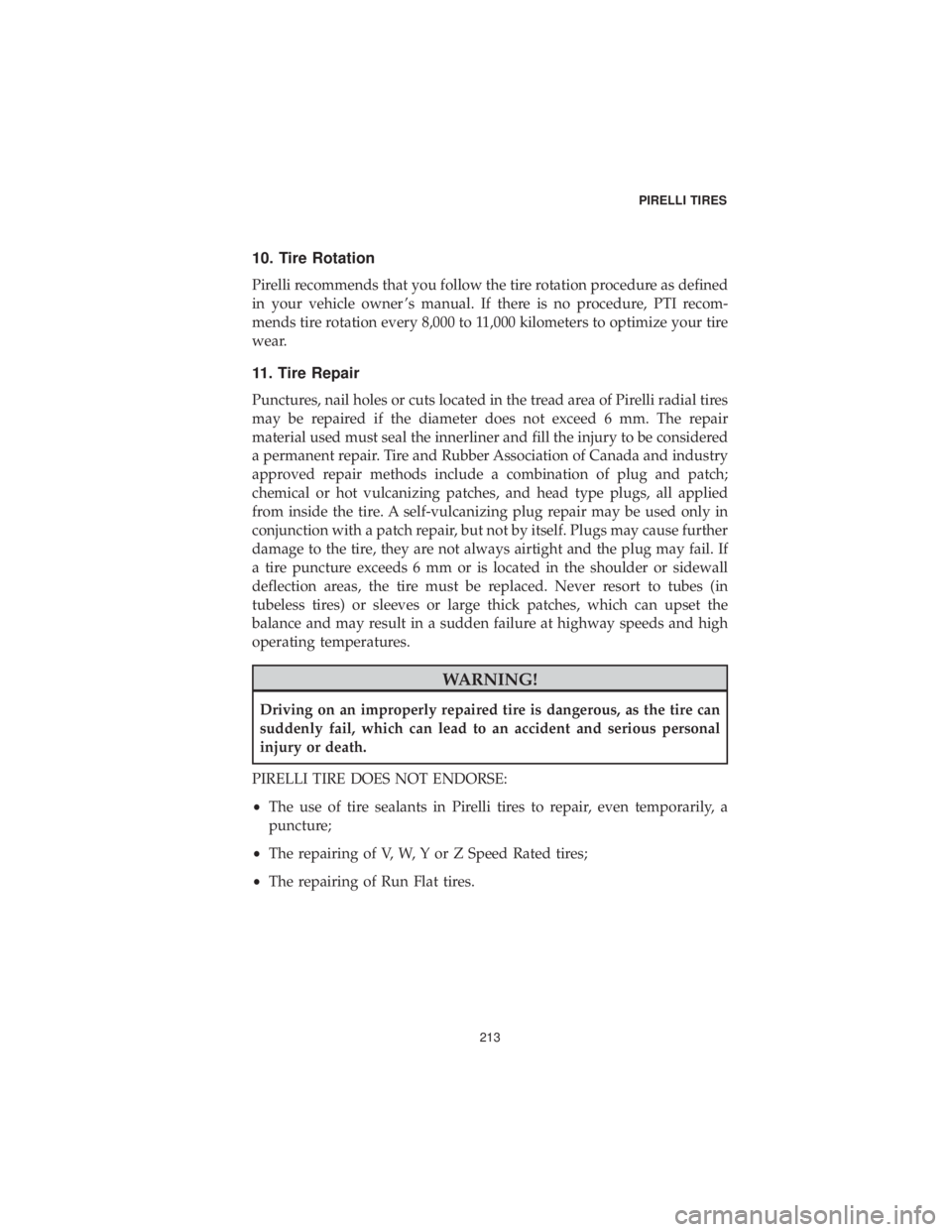
10. Tire Rotation
Pirelli recommends that you follow the tire rotation procedure as defined
in your vehicle owner ’s manual. If there is no procedure, PTI recom-
mends tire rotation every 8,000 to 11,000 kilometers to optimize your tire
wear.
11. Tire Repair
Punctures, nail holes or cuts located in the tread area of Pirelli radial tires
may be repaired if the diameter does not exceed 6 mm. The repair
material used must seal the innerliner and fill the injury to be considered
a permanent repair. Tire and Rubber Association of Canada and industry
approved repair methods include a combination of plug and patch;
chemical or hot vulcanizing patches, and head type plugs, all applied
from inside the tire. A self-vulcanizing plug repair may be used only in
conjunction with a patch repair, but not by itself. Plugs may cause further
damage to the tire, they are not always airtight and the plug may fail. If
a tire puncture exceeds 6 mm or is located in the shoulder or sidewall
deflection areas, the tire must be replaced. Never resort to tubes (in
tubeless tires) or sleeves or large thick patches, which can upset the
balance and may result in a sudden failure at highway speeds and high
operating temperatures.
WARNING!
Driving on an improperly repaired tire is dangerous, as the tire can
suddenly fail, which can lead to an accident and serious personal
injury or death.
PIRELLI TIRE DOES NOT ENDORSE:
• The use of tire sealants in Pirelli tires to repair, even temporarily, a
puncture;
• The repairing of V, W, Y or Z Speed Rated tires;
• The repairing of Run Flat tires.
PIRELLI TIRES
213
Page 227 of 270
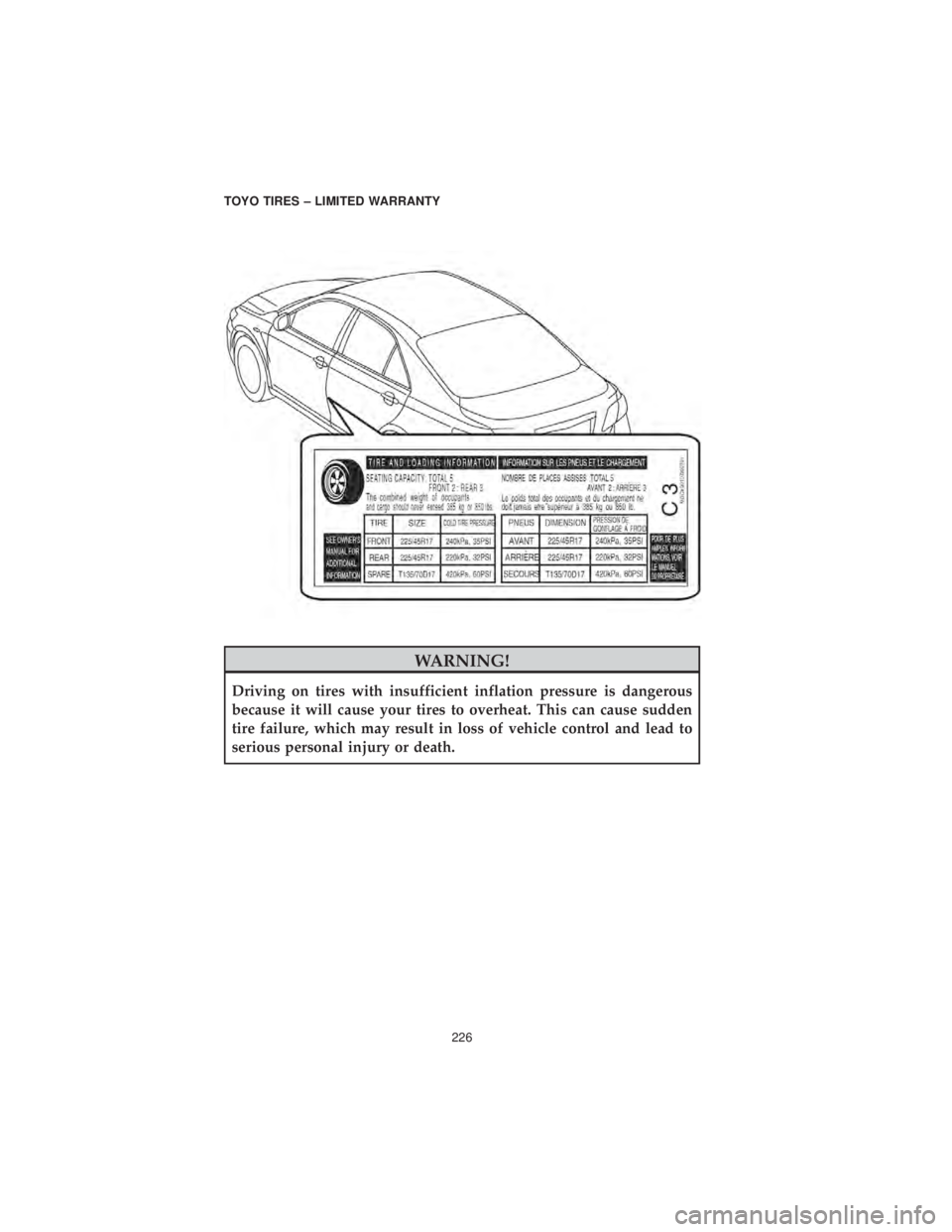
WARNING!
Driving on tires with insufficient inflation pressure is dangerous
because it will cause your tires to overheat. This can cause sudden
tire failure, which may result in loss of vehicle control and lead to
serious personal injury or death.
TOYO TIRES – LIMITED WARRANTY226
Page 229 of 270
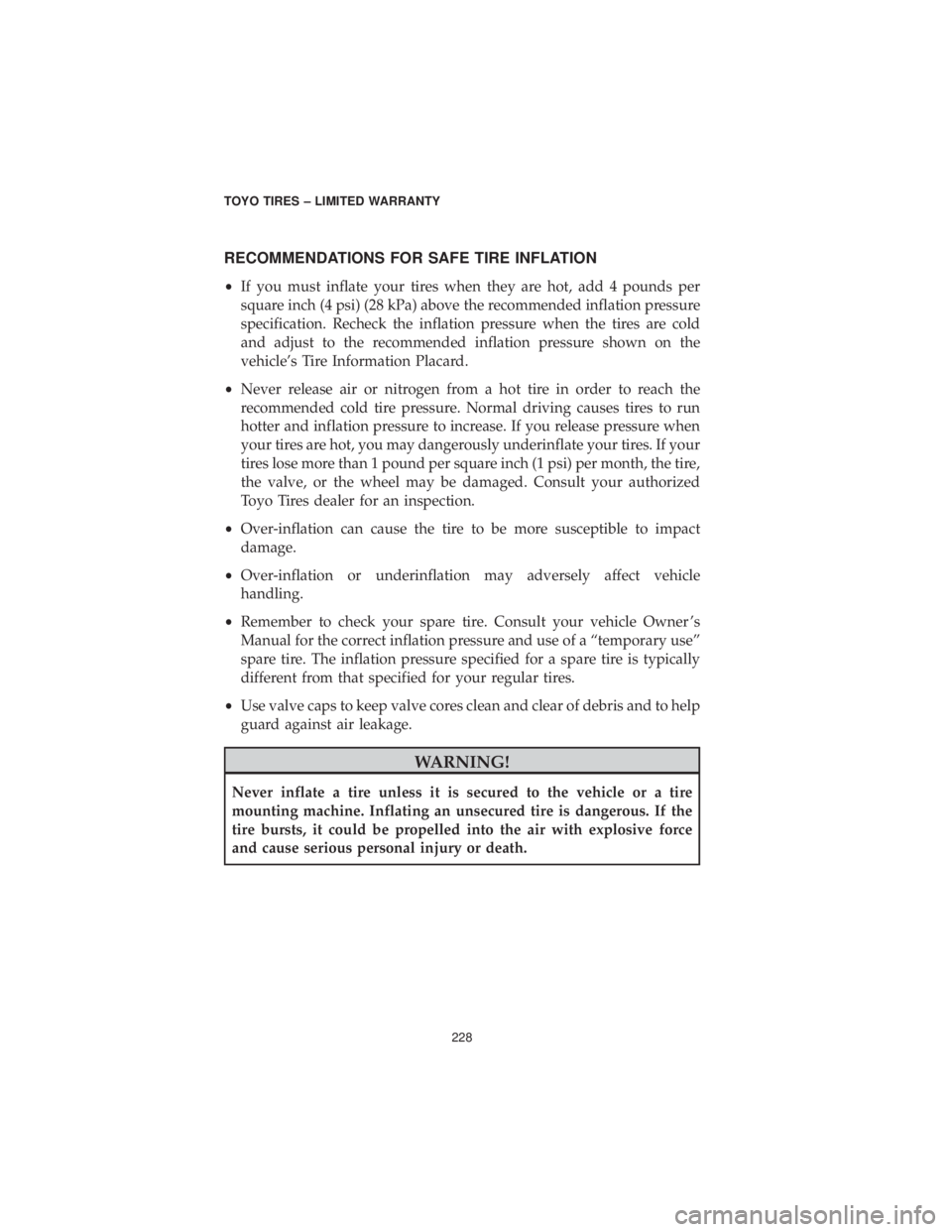
RECOMMENDATIONS FOR SAFE TIRE INFLATION
•If you must inflate your tires when they are hot, add 4 pounds per
square inch (4 psi) (28 kPa) above the recommended inflation pressure
specification. Recheck the inflation pressure when the tires are cold
and adjust to the recommended inflation pressure shown on the
vehicle’s Tire Information Placard.
• Never release air or nitrogen from a hot tire in order to reach the
recommended cold tire pressure. Normal driving causes tires to run
hotter and inflation pressure to increase. If you release pressure when
your tires are hot, you may dangerously underinflate your tires. If your
tires lose more than 1 pound per square inch (1 psi) per month, the tire,
the valve, or the wheel may be damaged. Consult your authorized
Toyo Tires dealer for an inspection.
• Over-inflation can cause the tire to be more susceptible to impact
damage.
• Over-inflation or underinflation may adversely affect vehicle
handling.
• Remember to check your spare tire. Consult your vehicle Owner ’s
Manual for the correct inflation pressure and use of a “temporary use”
spare tire. The inflation pressure specified for a spare tire is typically
different from that specified for your regular tires.
• Use valve caps to keep valve cores clean and clear of debris and to help
guard against air leakage.
WARNING!
Never inflate a tire unless it is secured to the vehicle or a tire
mounting machine. Inflating an unsecured tire is dangerous. If the
tire bursts, it could be propelled into the air with explosive force
and cause serious personal injury or death.
TOYO TIRES – LIMITED WARRANTY
228